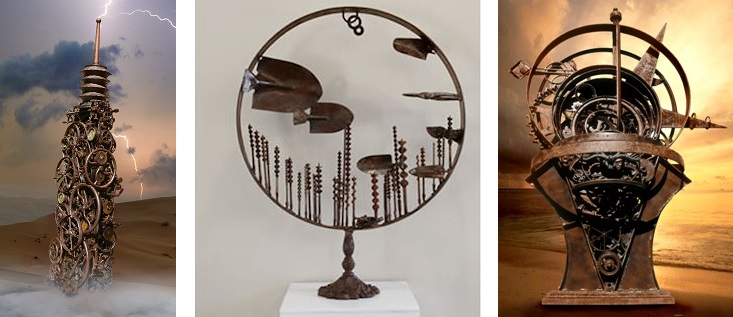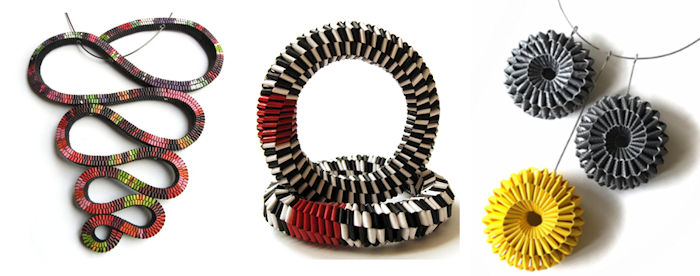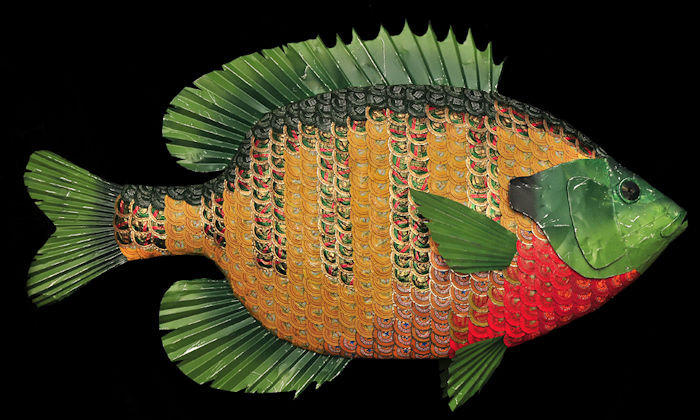Artists Care About Saving the Earth
By Claire Larrabee
Today, many artists are not only striving to bring their creative ideas to life, but also working to make their art play a role in saving the earth. Artists who care about saving the earth express their concerns in a variety of ways, such as reusing existing materials or using only natural materials to bring fresh new ideas to life. For others, the environment is the subject itself. They create work that reminds us not only of the beauty of the land, ocean, and creatures around us, but also of the fragility of the environment.
Many of the artists and makers who participate in Paradise City Arts Festivals are creating beautiful works that they hope will contribute to saving the earth. Here is a look at just a few of them.
From Rust to Artistic Riches
Ever wondered what to do with that rusty old tool lingering in your basement or bent spoon that is no longer of use? James Kitchen knows exactly what to do with rusting-away objects because he has been welding scrap metal into stunning sculptures for fifteen years at his studio in Chesterfield, Massachusetts. All of the metal he uses is recycled, as he scours local farms, junkyards, antique stores, and auctions for unloved pieces that can be transformed into art. Even the neighbors get into the recycling act, leaving piles of interesting objects in his driveway!
Left to Right: Denkmal, Aquarium, Universe Revealed
What fascinates James about old metal objects is that they carry a rich history of his community. “I feel part historian and part archeologist, creating new life,” James says. He usually works on multiple sculptures at a time, letting them organically grow and change as he finds new objects to reveal the often-amusing personality of each piece.
Trash to Treasure
Francesca Vitali is her own one-woman recycling factory as she takes the cast-off papers of life and turns them into amazing pieces of jewelry. Francesca loves the process of changing ordinary magazines, shopping bags, old maps, and vintage papers into mind boggling necklaces, earrings, bracelets, and pins. She enjoys that not only is she transforming humble refuse paper into precious objects, but that each piece she makes contains the fragments of another person’s life living forever in her jewelry.
Francesca Vitali’s imaginative jewelry turns unwanted pieces of paper into works of art.
All Creatures Great and Small
Wild creatures endangered by pollution, invasive plant, animal and insect species, mythical and extinct critters, and even household pets inhabit the animal-filled world of woodcut artist and ceramicist Jenny Pope. For her prints, Jenny uses a painstaking technique called “color-reduction woodcuts” which requires drawing an image on a block of wood, then carving away the wood layer by layer for each planned color of the print.
Jenny Pope carefully carves away multiple layers of wood to produce woodcuts that capture the brilliant colors and movement of animals.
(Left to Right: Flippers and Spikes, Moonlight Migration, Resident Cardinals)
A few years ago, one of Jenny’s friends introduced her to working with clay. Jenny found carving clay was a natural extension from her woodcarving, and she loved the opportunity to work with a soft, malleable material. All of her creature-filled clay work is hand built, hand painted and hand carved. These days, she divides her time equally between clay and woodcuts.
How to Wear Nature on Your Sleeve
For Amelia Poole, her love of the natural world guides the way she makes her sustainable silk scarves and clothing. One of her primary techniques is eco-printing, which layers natural fiber cloth and paper with local plants and flowers to transfer the pattern and colors of the plants to the fabric.
To make an eco-print, Amelia Poole arranges the plant material on the cloth, then tightly wraps and steams the bundle. The result is a soft, wearable fabric infused with the colors and patterns of the plants.
Amelia also works with indigo, a blue dye extracted from the leaves of the Indigo plant, to color her natural linens, silk, hemp and organic cotton. She uses Shibori, an ancient Japanese technique, which creates patterns by binding, stitching, folding, and twisting fabric to prevent the Indigo dye from penetrating all parts of the cloth.
Amelia Poole uses all-natural materials to create her clothing.
(Left to Right: Eco-print fabric, eco-print dress, indigo-dyed Shibori scarf)
A Fish Tale: Bottle Caps and Barracudas
Woody Blackwell is quite obsessed with a) bottle caps and b) fish. Two things in this world you wouldn’t normally associate with one another ‒ unless you count popping the cap off a cold brew while fishing off the dock! But in Woody’s imagination, they are a natural fit. Used bottlecaps, old tins for blasting caps, udder balm, chewing tobacco, and floor finish, even nails and upholstery tacks – all of these unlikely objects are the means to create some astounding images of ocean and lake fish. Despite his use of these odd materials, Woody strives for authenticity, crafting each gill, fin, and tooth to be as realistic as possible.
Woody Blackwell used seven kinds of reclaimed bottle caps to create this sunfish.
The barracuda’s scales are made from bottle caps and the teeth are upholstery tacks, which Woody describes as “wicked sharp.”
Paradise City Arts Festivals Feature Eco-Friendly Artists
Supporting artists like James Kitchen, Francesca Vitali, Jenny Pope, Amelia Poole, and Woody Blackwell is a wonderful way to contribute just a little bit more to helping save the earth. Naturally, you will find all these eco-friendly artists at the upcoming Paradise City Arts Festivals in October and November, along with many other skilled artists who are using their work to express their environmental concerns.
The October festival takes place October 6-8 at the Three County Fairgrounds, 54 Old Ferry Road, Northampton, MA. The November show will be November 16-18 at the Royal Plaza Trade Center, Marlborough, MA. Mark your calendars now so you don’t miss the fun!







